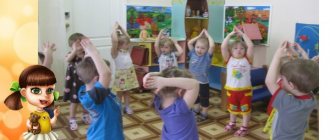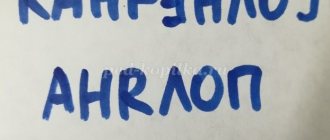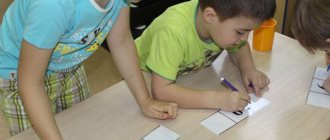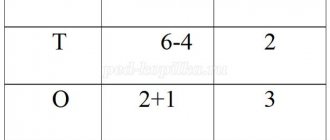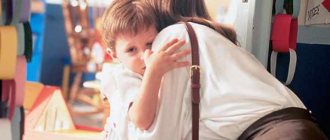Math quest and how to do it
The word “quest” comes from the English “quest”, “goal, task”; this word is also used to mark tasks in games, both computer and tabletop. In other words, a quest is a chain of tasks presented in a game form.
Note! Such an event can be done with or without a plot.
For example, children aged 5–6 years are still interested in watching the story about Baba Yaga and Little Red Riding Hood, but children aged 6–7 years may feel a little awkward.
Then it is better to put the quest in a more “adult” form, calling it, say, “Sports Math Quiz,” or make a story where the main character will be a detective, and he will investigate the case of missing answers to questions in a test. If the institution has a projector, then a background video can be installed to create the appropriate atmosphere. In order not to waste time downloading, you can launch it online. It is precisely these nuances that distinguish truly entertaining mathematics for children from ordinary lessons.
Nothing makes an event more interesting for children than the opportunity to have fun
Important! It is necessary to understand that the quest is, first of all, an entertaining event, and the teacher must be prepared for the fact that the interest of children is more important than the quality of the information conveyed.
Thematic week in the second junior group “Professions”
This is not a lesson, a test, or a test. A good math riddle for children is one in which he wanted to find the answer, but not one where the answer was complicated and boring. Also, the child must have a reason to participate in a strange and incomprehensible action. Such a reason could be a certificate or a sweet prize.
The process of creating a quest looks like this:
- Come up with a story or reason why children will have to solve certain problems.
- Divide the quest into several stages (more on this below).
- Distribute the locations, keep in mind that in order to carry out the quest efficiently, you will have to distribute the children into groups of no more than 5 people, otherwise it will not be possible to pay enough attention to everyone at each stage. (If there are not enough teachers to work in parallel, you can conduct a regular lesson with part of the group, and a quest with the other, and swap them in the next lesson. (Or conduct a KVN, but more on that later).
Each quest should have the following several parts:
- The initial stage, in which you need to explain to the children what is happening now, talk about the rules of behavior in such a lesson. It is worth limiting yourself to a few easy tasks, giving priority to the involvement and interest of children.
- The main action in which children will move around locations and solve problems.
- The culminating part, in which the winners, if any, will be awarded (the best way out here would be to allocate first place, and give the rest diplomas / awards “for active participation”, “for the best poem”, etc.).
- Summing up is an important point that many scripts miss. A child always wants to feel important and grown up; he appreciates being appreciated. It is necessary to divide the children into groups and give them the opportunity to speak out about what happened, after which they should be carefully led to the idea that mathematics is more interesting than it seemed before. At this moment, the teacher should not be too persistent: feeling that someone else’s opinion is being imposed on him, the child may close himself off from the subject for a long time.
Differences between quests and quizzes for senior and preparatory groups
The more adult a child becomes, the less “childish” the quest should be in his eyes. It is clear that, in fact, a 6-year-old child is not as radically different from a five-year-old as he would like to think, but he feels as if he is a whole generation ahead of this toddler! Therefore, in the older group it is necessary to modify the classic math quest.
In order to show the exclusivity and peculiarity of the elders, it is recommended to make them assistants from ordinary participants. Let the children create a few puzzles themselves; the teacher needs to talk about how such an activity is conducted, and then invite them to make their own quest. (Don't forget to warn your parents).
Note! After that, you need to lead the younger group along the route invented by the graduates, and let them have fun together.
However, unfortunately, this event will require a really large number of adults, because you will need to constantly monitor twice as many children. If the kindergarten cannot afford this, you can replace the quest with a quiz in which older children will ask questions to younger ones. The winner among the “organizers” will be those whose questions turned out to be the most difficult.
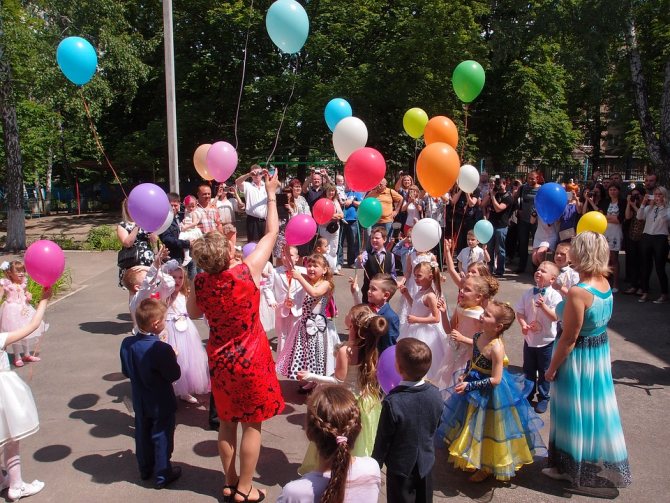
And at the end of the event, you can launch balloons into the sky, which will cause sincere delight in children
Reconciliation with Federal State Educational Standards
In fact, violating the regulations of federal state educational standards is much more difficult than it seems at first glance. If a teacher has experience working in a preschool educational institution, then most likely he intuitively understands what can be done and what cannot be done. If the quest is being developed for an expert commission or an open lesson, then it is better, of course, to print the regulations from the official website of the Federal State Educational Standard.
But in any case, we should not forget that children in kindergarten are still too young to seriously study any sciences. In accordance with this, it is necessary to structure all pedagogical activities (like any mathematical quest in the preparatory group) in the kindergarten in such a way that the kids do not get tired and begin to dislike the exact sciences, which they will begin to study very soon at school.
Rules for conducting mathematical KVN and coming up with jokes for preschoolers
Such an event is a much more difficult task than it seems at first glance. The whole problem is that the humor of children and the humor of adults are two completely unrelated categories.
Note! The best solution to this problem would be to replace humor with some other amateur activity, say, theatrical skits or songs.
This will make it much easier to create joke math problems for preschoolers. Children will be able to prepare such work together with their parents, gathering at each other’s houses (of course, if the math quest was originally planned to be carried out in the older group).
Drawing on the theme “Mimosa in a vase” for senior and preparatory groups
Note! It is imperative to ensure that there is no inequality between children, and that sufficient time is given to everyone.
It is better to leave the humorous part of the event entirely in their care. It should be remembered that it should be funny for the main participants of the holiday, and not for the parents and teachers who have gathered to watch them. A moment that is humorous for adults may not be funny for children.
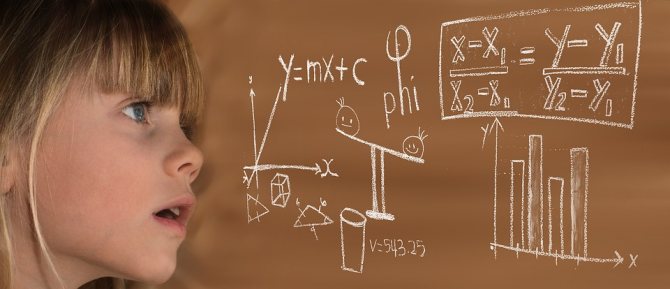
At such an event, a child will be able to solve even the most difficult problem for him.
MAGAZINE Preschooler.RF
Organization of gaming activities in the preparatory group. Mathematical quest "Piggy Bank".Author of the abstract: Isaeva E.V. Novosibirsk MKDOU No. 176 d/s “Smile”
Priority educational area: NGO "Mathematical Development" .
Developing subject-spatial environment: group room, pictures: depicting conditions for mathematical problems; letters for composing words and encoding; conditions for logical problems using Dienesh blocks, a set of numbers and mathematical symbols.
Goal: creating conditions for children to develop interest in mathematical knowledge.
Educational objectives:
- Continue to develop the ability to solve logical problems relying on exclusionary features.
- Consolidate knowledge about geometric shapes and their characteristics.
- Continue to develop knowledge about ordinal counting within 10, strengthen the graphic perception of numbers.
- Continue to form an idea of equality, strengthen the ability to correlate equality with the equal sign (=).
- Continue to develop the ability to compose mathematical problems based on pictures and make mathematical notations.
Educational tasks:
- Continue to develop the ability to work as a team and follow the rules of behavior.
- To form an understanding of how interesting and important it is to act together and gain new scientific knowledge.
Introductory part (motivational, preparatory stage)
The teacher is having a conversation with the children on the topic of letters to friends, during the conversation they hear noise in the reception area, the children go out to the reception area and notice two letters in the mailbox.
D: guys, letters have appeared in our mailbox! Let's quickly find out who they are from. Children express their guesses. Children read independently from whom and to whom.
Q: letters from the Queen of Mathematics!
Look at two envelopes, it says that you and I can open one right now (there is a letter in the envelope with task No. 1), and to open the other, you need to get 10 coins.
They read the letter.
Hello children, I found out that you really love mathematics - this makes me happy! I have prepared a gift for you, where it is written in a sealed envelope, you can open it by getting 10 coins. You can get coins by completing 5 tests, look for clues and coins. The first test awaits you on your tables. Good luck!
Q: Everything is clear, the queen invites you and me to take part in the quest.
That’s great, because the quest is a very interesting journey! Ready?! Let's split into 2 teams.
Would you like me to tell you the secret to successfully completing the quest?
- Don't interrupt each other.
- Act together.
- Be careful.
V.: Since you and I are ready, let’s begin!
Main part (content active stage)
1 “Let’s fix the carpet . Children receive diagrams with several signs on
exception. Ref: this figure
solution: big yellow circle.
Schemes are selected depending on the level of preparedness of children.
Approach the tables; on them there are Dienesh blocks and conditions for the task. At the signal, we begin to solve the problem, and our carpet will help us check whether you have decided correctly; if so, then a patch on the carpet will do (overlay method). On the back of the carpet, children find a clue where to look for challenge No. 2 and 2 coins.
Well done, the next task for you and me is in the reception area, let's go quickly!
2 "Settled in with neighbors"
Guys, in front of you lies a sheet on which houses with numbers are drawn, you need to write in the neighbors of the numbers with a pencil. We take three options for each team.
Great, let's look at the hint where to look for the next task (written on the back of the sheet with the task), look for the task where the girls often play (the kitchen corner), you will find the coins there.
3 "Encoding"
Before you is a coded word, in order to decipher it, you need to put the corresponding letters instead of numbers, be careful!
1 2 3 4 5
A V R N O
3 1 2 4 5
Words used for the cipher: equal, minus.
You are just super, let's look for a hint on where to move next (read on the back, the hint is from an adult in the group, this is not a teacher). They find a clue and move to the reception area. Back in the waiting room, in the cubicle of a child whose birthday is in April, go ahead!
4 "Fill and level the baskets"
Children receive sheets depicting 2 baskets of apples, with an equal sign between them.
Your task is to finish drawing the apples in the baskets so as not to break the equal sign.
Wow, how smart and clever you are, you can cope with all the tests, but what is this in my pocket (the teacher takes a piece of paper with a hint from his pocket, and later finds coins), wait, this is not mine, whose is it? Or maybe this is a hint, let's see!
A task awaits you where everyone can see themselves! Let's go look!
(On the mirror in the group).
5 “Make up a task and write it down”
Look carefully at the picture, come up with a problem, and use cards to write down a mathematical notation for it. Coins appear quietly on the table immediately after completing the task.
Great, let's count the coins!
Each team collected five coins, but to open the second envelope you need 10 coins, what should you do?
Children's answers 5+5 =10
That’s right, open the envelope (card diagram: the gift is located:
- not in the group, not in the kitchen, not in the toilet room (children's answers - in the reception area))
- in the booth there is a girl with dark hair whose name begins with the letter N. (children's answers - Nastya).
Let's go quickly!!!
(Children find a mathematical constructor)
Final part (reflective stage)
Q: You guys are great, I had so much fun with you, what about you?
D: yes!
Q: Today we completed many difficult tasks, was it difficult for you?
D: no.
Q: It’s because you are a great team!
I suggest you go play a new game!
| Next > |
